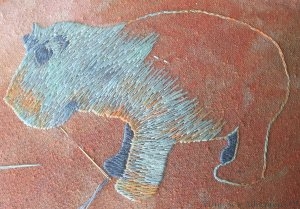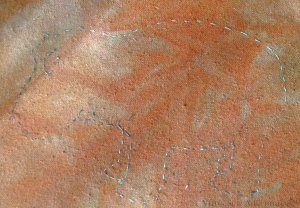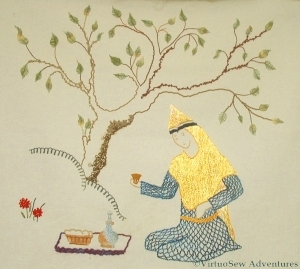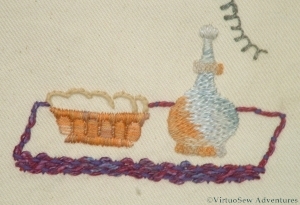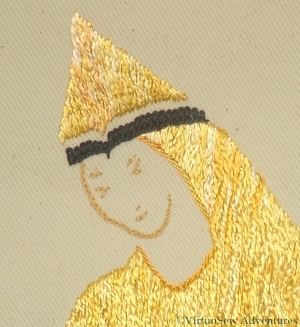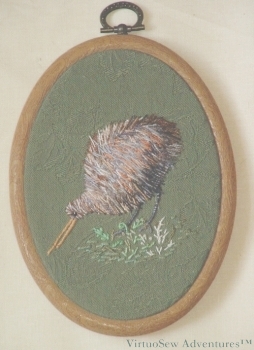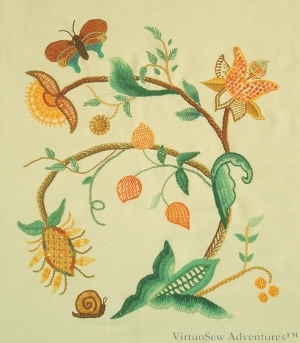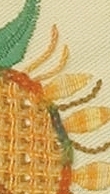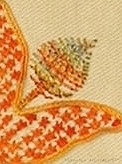Tag: overdyed threads
Dreams of Amarna – The Faience Hippopotamus, Second Stage
The reason I am calling this poor fellow an experiment is that I’m working him in long and short stitch. I have said that working on the Floral Glove Needlecase project has been illuminating and that I am warming to long and short stitch – well, we’ll see what I think when I’ve worked an entire piece in long and short stitch!
In the meantime, here he is, half done. The darkest and lightest shades are ordinary stranded cottons, but the middle three use overdyed threads. One of them shades from turquoise blue to russett, and the others are both fairly subtle variations on a dark and a light turquoise.
I am using two strands, with one of them turned end-to-end in comparison with the other. I’ve never done this before, but it means that the shading of the overdyed colours is slightly more spread out and more subtle than it would be if I left them both as they came off the skein. It also means that the twist in one strand runs counterwise to the twist in the other so one strand shortens during stitching. I’ve chosen not to mind about that, but if you did happen to mind I think the way to achieve the same effect would be to buy two skeins and start them at different points in the cycle of colours.
I’m also working in slightly untidy sections of the body, with two or three needles ready to go, depending upon the colour I need. I’m using long stitches, and aiming to cover the fabric beneath without packing the stitches too closely.
I’m really pleased with this so far. The colours are working well, and the variations will give a bit of modelling without attempting to create a needle painting.
Dreams of Amarna – The Faience Hippopotamus, First Stage
I have two Amarna projects already on the go (one of the backgrounds, and the Dig House) but they are both monochromatic, and you will have gathered that I like colour. So I thought I would experiment. Again!
My rule for the panels and motifs is that I may only depict items that Mary Chubb mentions, or that she would have known about, or which were excavated in Amarna about the time she was there. That means that anything seen in Howard Carter’s excavation of the tomb of Tutankhamun or excavated by Flinders Petrie is also allowed. So a faience hippo is just about permissible, as they seem to have cropped up in a lot of excavations, not just those of the Egypt Exploration Society. I’ve also just purchased (courtesy of Alibris, since it is out of print) “Tell el-Amarna”, by JDS Pendlebury, who was Director of the Excavation when Mary was Secretary. It should give me more ideas about what was known or thought at the time, which in turn will help me to plan more illustrations.
The background fabric is an overdyed silk noil from Stef Francis, and I will be using some of her stranded cottons as well. I began by copying the outline onto tissue paper and then went over the outline in running stitch. I rather like this technique for marking designs, at least where the design is relatively simple (see Ruth O’Leary’s Spirograph hangings for a less than simple design using the same transfer method – eek!).
I then stitched around the edges using split stitch to make the edge of the design clear, and took a deep breath…
The Persian Fantasy – extending the idea
The Persian Fantasy Screen was such fun that I wanted to do some more embroidery in the same style. First of all, it was clear from the original colours that the Prince on Panel One was the same on Panel Four, so I had to create a companion for him, the “Thou” of the text:
A loaf of bread, a flask of wine,
And thou beside me
Singing in the wilderness
And wilderness were paradise enow
I had some help from my mother on this one.. We used the illustrations in her copy of the Rubaiyat to help us with the lady’s costume and to find a different sort of tree for her to sit under. The pictures were from ancient Persian silk paintings, so I hoped that our prince and his partner would recognise one another. I used the same technique for the tree – couched chenille, boucle and loop yarns, and simple shapes for the leaves, although in this case the leaves also used a variegated yarn. I also used a similar idea for the lady’s outfit as I had for the prince, choosing an openwork filling stitch (in this case, Cloud Filling Stitch) for the tunic, and something more solid for the headcovering.
Again, the dishes for the picnic included lustreware, this time a bowl full of bread. This time the lustreware was worked in overdyed stranded cotton. There was also a flask using similar colours to the prince’s lustreware, but worked this time in variegated cottons. The little table (or rug – I never quite decided what it was!) that the picnic is placed on was edged with a complicated couched braid, using an even more complicated textural thread. I can’t for the life of me recall where I bought it, but I do recall that the only possible way to use it was by couching it!
A loose rayon, worked in a sort of halfway stitch between Bokhara couching and Romanian couching, created the lady’s glowing veil, and her headband was worked in braid stitch to give a suitable ornate and luxurious appearance.
I’m not sure that I would use these stitches or threads now. I remember the untwisted rayon was difficult to stitch, very flyaway and prone to catching on my hoop, my fingers, my nails (even though I keep them short) and anything else within range. It looks lovely now it’s done, of course. . .
Trying Stumpwork
As I’ve already mentioned, almost every embroidery technique I have done has been learnt from a book, or just developed by guesswork based upon something I have read.
In this case, I had been reading about 17th Century stumpwork, and had just returned from a half-business trip, half-holiday in New Zealand. And I had some rather gorgeous overdyed silk threads and wanted to experiment with them!
The body is worked in layers of straight stitches, using several different colours of the overdyed silks. I worked a slip, slightly smaller than the body, on a separate piece of fabric, then applied that piece over some padding, and used more straight stitches to cover the join – very thoroughly!
The legs and the beak are both worked by stitching very closely over a trailing thread of soft cotton. The background fabric is a sturdy cotton damask upholstery fabric, so the close stitchery did no harm. The ground is worked using still more straight stitches, with scroll stitch, coral stitch and fern stitch to create the fragmentary undergrowth.
This was intended just as a piece of fun, but I was happy enough with the outcome to mount it in a flexihoop frame. I’ve bought a couple of books on Stumpwork since I stitched this, but I don’t know that I would have thought of doing the Kiwi this way if I had read the books first.
Where, oh where, did my header come from?
I designed and embroidered this piece shortly after I was married. It was my first design for Our House, and I suspect it gave my husband fair warning (if he hadn’t already guessed) that furnishing it would not be a simple matter of a trip to a furniture shop!
I took some of the motifs from a tablecloth that Grandmama stitched using surface embroidery and needlelace. Then I combined them with some Jacobean leaf shapes and the occasional curlicue. The snail and the butterfly are added because Jacobean designs often included bugs and animals, and although our house is nearer to Arts & Crafts in style than Jacobean I wanted to work on a Jacobean crewel-style design.
I had enormous fun playing with ornamental stitches and threads. There are Persian wools, soft cottons, pearl cottons, stranded cottons, rayons. The butterfly even had some metallic thread in it, and I don’t often use metallics. Stitches included Battlement Couching, and Pekingese Stitch using overdyed chenille thread, and open Fishbone stitch in a crinkly overdyed rayon.
That rayon thread is much more difficult to embroider with than the chenille, but I am realising as I photograph and study some of my past embroideries that I seem to use a great deal of it. I should have a stern word with myself about that, because every single stitch with that thread is accompanied by muttered swearing – which can’t possibly be good for me!
I seem to be going through a phase of gold and teal at the moment, so when I wanted a picture of some of my embroidery to put in my header, this seemed the obvious one to pick. I’m not wholly happy with some elements of the design, but every time I see it I remember the fun I had making it. So it is a good representation of the sort of “virtuosewer” I would like to be.

